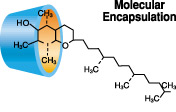
A new molecular encapsulating agent that can be ground into various particle sizes while giving stability to large molecules, such as triacylglycerides with omega-3 fatty acids, is now on the market.
Molecular Encapsulation
Classified as oligosaccharides, cyclodextrins are bucket-shaped molecules made from glucose units. Commercially available forms include alpha (a), beta (b) and gamma (g) cyclodextrins, which are composed of six, seven and eight glucose units, respectively. It is their circular shape, however, that enables them to act as a protectant and carrier for nutritional and functional ingredients, such as vitamins, nutritional lipids and flavors. Additionally, they mask off-flavors associated with certain nutritional ingredients.Many food professionals in the U.S. food industry were first introduced to cyclodextrins in 1997, when a self-affirmed GRAS petition allowed the b form to be used as a flavor carrier and a protectant at a level of 2% in numerous food products. Cyclodextrins' three-dimensional structure makes these molecules less polar on the interior of the "buckets" than on the surface, allowing them to form inclusions of fat-soluble molecules. That is, molecules with hydrophobic portions are attracted to cyclodextrins' hydrophobic interiors.
Such "molecular encapsulation" stabilizes compounds. For example, the loss of volatile flavorings to the atmosphere can be significantly reduced. Lipid-soluble flavorings, vitamins A and E and polyunsaturated fatty acids --such as menhaden fish oil with omega-3 fatty acids-- can also be protected from oxidation. Encapsulation not only delivers a fully functional ingredient to the end consumer; it also masks unpleasant tasting nutritional ingredients. Furthermore, the development of off-flavors from oxidized polyunsaturated fatty acids are also lessened or eliminated.
As helpful as the regulatory approval of b cyclodextrin was, its ring was not big enough to accommodate larger sizes of molecules. This is where the g form is needed.
Great Gamma
In May 2000, Wacker Biochem Corp. notified the FDA that an independent, international expert panel had found g cyclodextrin to be GRAS for use as a stabilizer, emulsifier, carrier and formulation aid. Both scientific procedures and an evaluation by the Joint Food and Agriculture Organization/World Health Organizations' Expert Committee on Food Additives were considered in reaching the decision. The FDA did not question the self-affirmed GRAS status and, in September 2000, assigned it the GRAS Notice No. GRN 000046. (See also http://vm.cfsan.fda.gov/~lrd/foodadd.html.)Work at Wacker Biochem shows that when complexed with g cyclodextrin, the oxidative stability of triacylglycerides--whether from algae, fish or vegetable sources--is greatly increased. Optimal results are obtained with a 25% menhaden oil concentration, which corresponds to a 2:1 oil to cyclodextrin molecule ratio. Other applications and use levels range from 1 to 90%, as seen the chart on this page.
For
more information call 517-264-8794.
| Gamma Cyclodextrin Use Levels | |
| Application | Maximum Use Levels |
| Carrier for flavors, sweeteners and colors dry mixes, breakfast cereals, savory snacks, etc. 1% | |
| Carrier for vitamins 90% | |
| Carrier for polyunsaturated fatty acids 80% | |
| Flavor modifier in soya milk 2% | |
| Stabilizer in: | |
| fat-reduced bread spreads 20% | |
| fat-based fillings 5% | |
| fruit-based fillings 3% | |
| dairy desserts 3% | |
| processed cheese 3% | |
| bread 1% | |
| other baked goods 1% | |
 Claudia Dziuk O'Donnell is Chief Editor and Associate Publisher of Prepared Foods magazine including its NutraSolutions and Culinary sections. Her responsibilities include determining the editorial content of the print publication and the New Products Conference.
Claudia Dziuk O'Donnell is Chief Editor and Associate Publisher of Prepared Foods magazine including its NutraSolutions and Culinary sections. Her responsibilities include determining the editorial content of the print publication and the New Products Conference.